Homemade Sourdough Bagels – With Video
Sourdough bagels are chewy, crusty and properly dense. They have an extra deep flavor thanks to the sourdough starter in the recipe. This recipe take more than 12 hours to make, but the vast majority of the time is hands-off.

I’ve said it before, I think a good bagel should have a nicely dense and chewy texture with a toothsome crust. Forget the frozen hockey pucks from the grocery store, and the bagels from chain bakeries that are way too fluffy to be a real bagel.
Homemade bagels are not hard to make and they freeze beautifully. If you set aside a little time over a weekend, you can stock up the freezer for weeks to come.
This Sourdough Bagel recipe is a variation of my popular recipe for New York Style Bagels.
If you don’t already have one, I can show you how to make a sourdough starter and how to feed a sourdough starter.
Ingredients
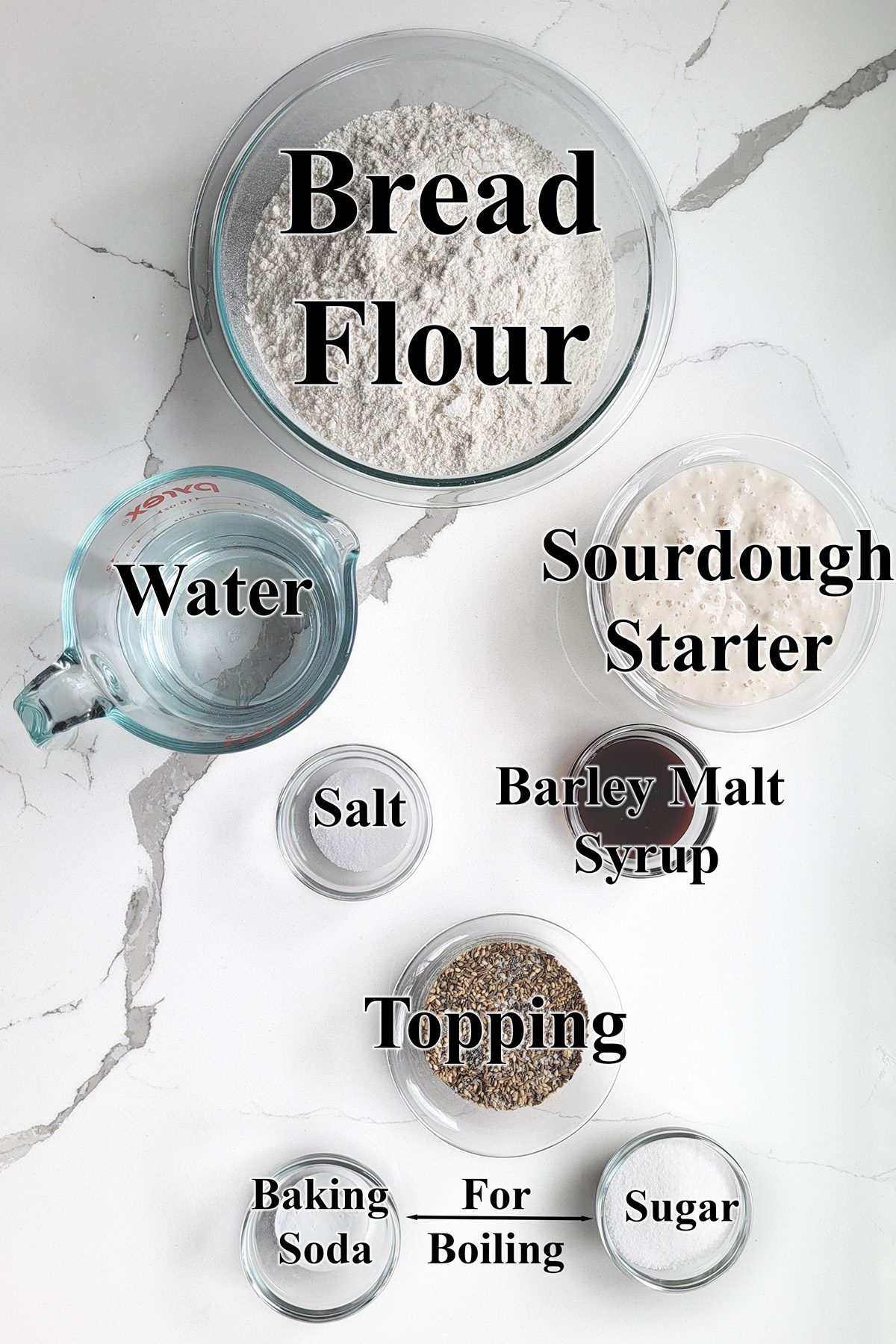
Ingredient Notes
- Bread Flour – Bagels should have a very chewy crumb from a strong gluten network in the dough. High protein bread flour develops plenty of gluten.
- Sourdough Starter – The recipe was developed using 100% hydration starter. You will need to adjust the liquid or flour in the recipe if you’re starter isn’t at 100% hydration. Your starter should be fed and active when you mix the bagel dough.
- Barley Malt Syrup – Adds a traditional slightly sweet note to the dough. You can substitute honey or a combination or honey and molasses for the barley malt syrup.
- Toppings – Leave the bagels plain or use your favorite seed for topping. You can mix seeds with salt to make your own “everything” bagel topping”. See the recipe card for details.
- Baking Soda & Sugar – For boiling the bagels. The boiling process creates the specific shiny and chewy bagel crust.
Process photos for making Sourdough Bagels
See the recipe card for detailed measurements and instructions.
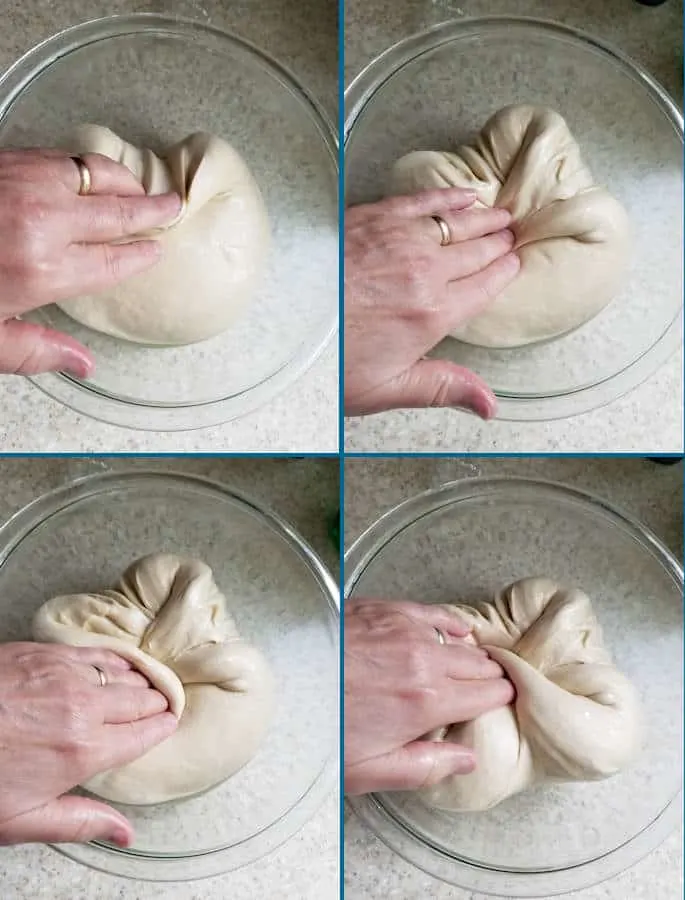
- As the dough ferments, it should be folded onto itself every hour or so to redistribute the yeast.
- Fold from each side into the middle, then flip the dough over.
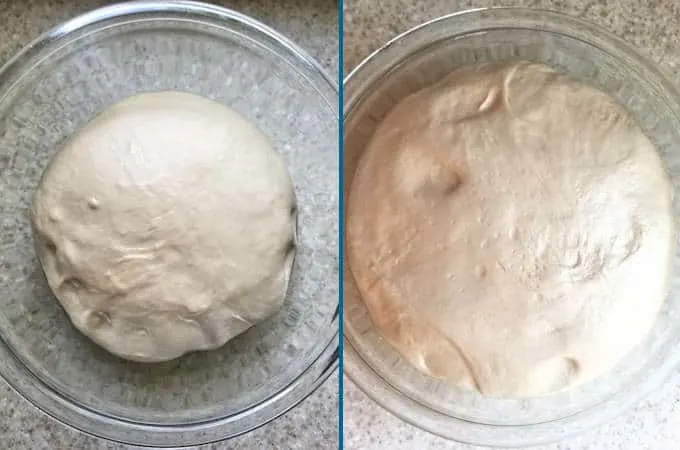
- After 30 minutes there’s not much activity in the dough (left).
- After 3 hours the dough should be active and nicely aerated (right).
- After fermentation it’s time to shape the bagels.
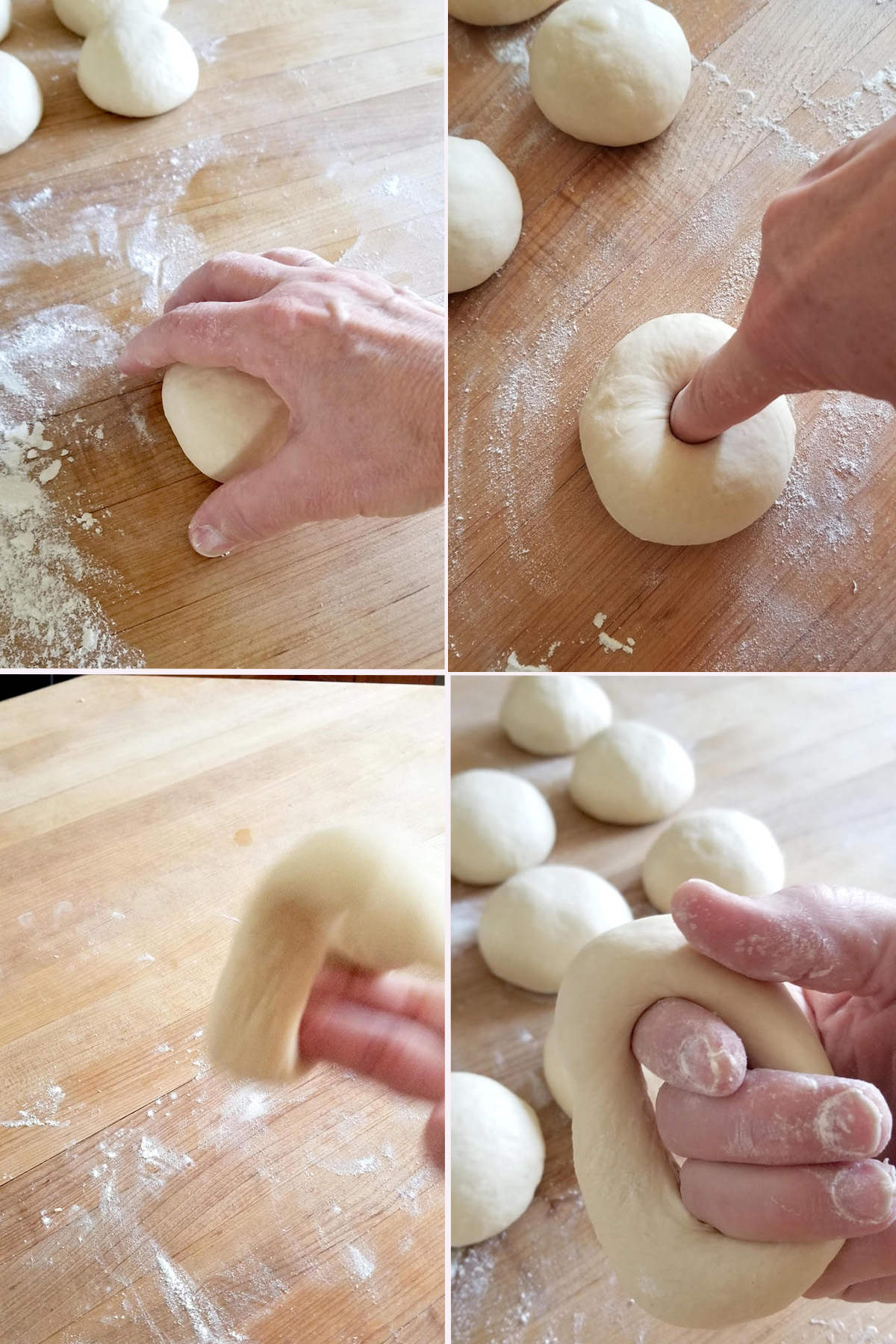
- Use a cupped hand to form the a piece of dough into a tight ball. Repeat with all the pieces of dough.
- Poke your finger all the way through the center of the ball to make a hole.
- Twirl the dough around your fingers to widen the center hole.
- Set the bagel onto the baking sheet and continue with the rest of the dough.
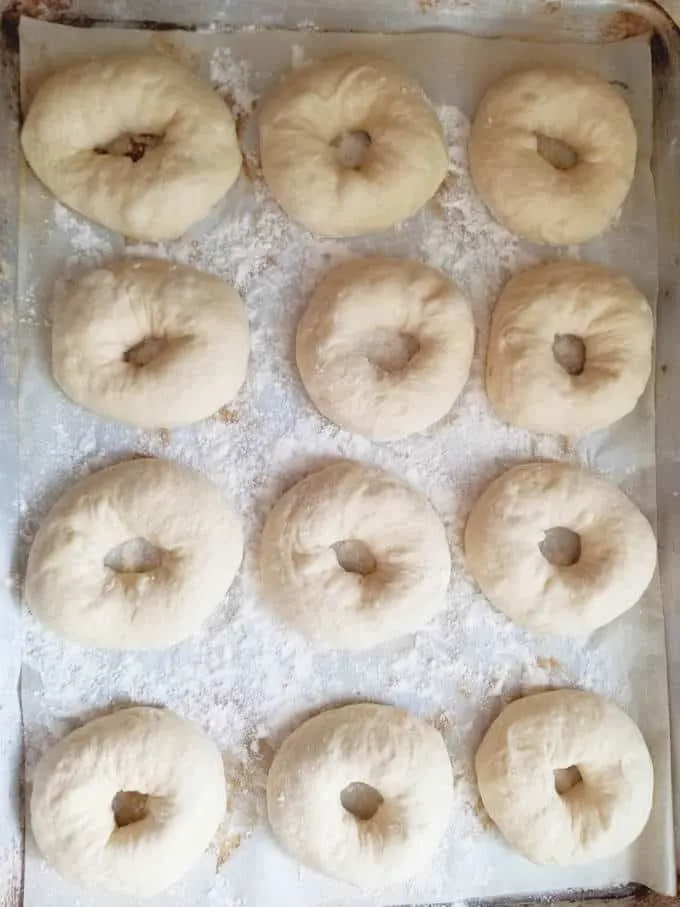
- Line the formed bagels onto a well-floured (or use cornmeal) sheet pan to prevent sticking.
- Cover the pan and place it in the refrigerator overnight.
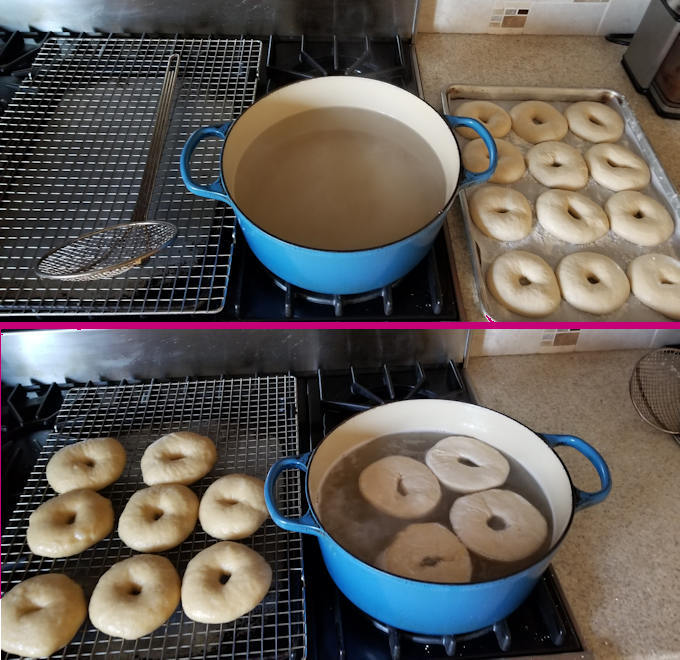
- Bring a pot of water with baking soda and sugar to a boil. Preheat the oven.
- Boil the bagels a few at a time, flipping them every thirty seconds. Boil each batch for 2 minutes.
- Transfer the bagels to a rack to drain while you finish boiling the rest of the bagels.
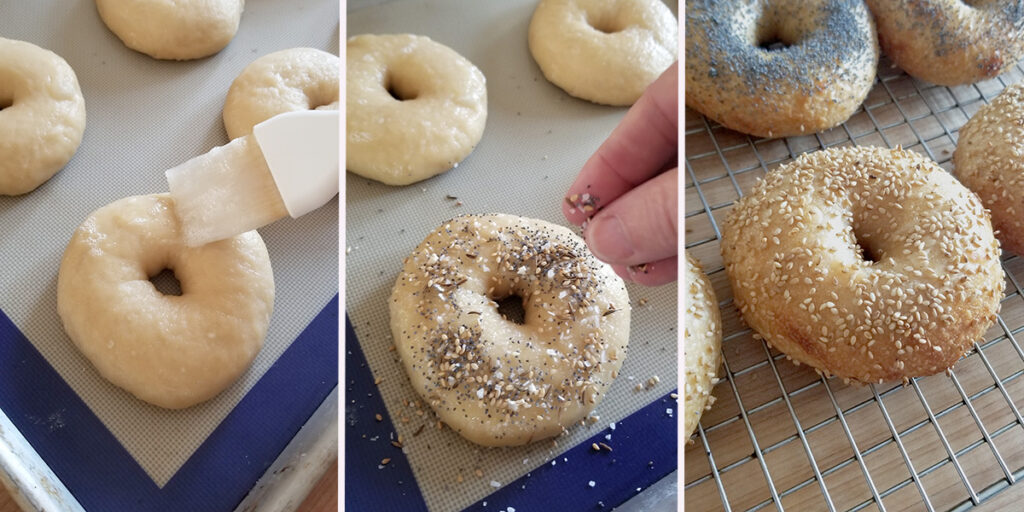
- Brush the boiled bagels with egg white.
- Sprinkle seeds or bagel topping if desired.
- Bake until the bagels are golden brown.
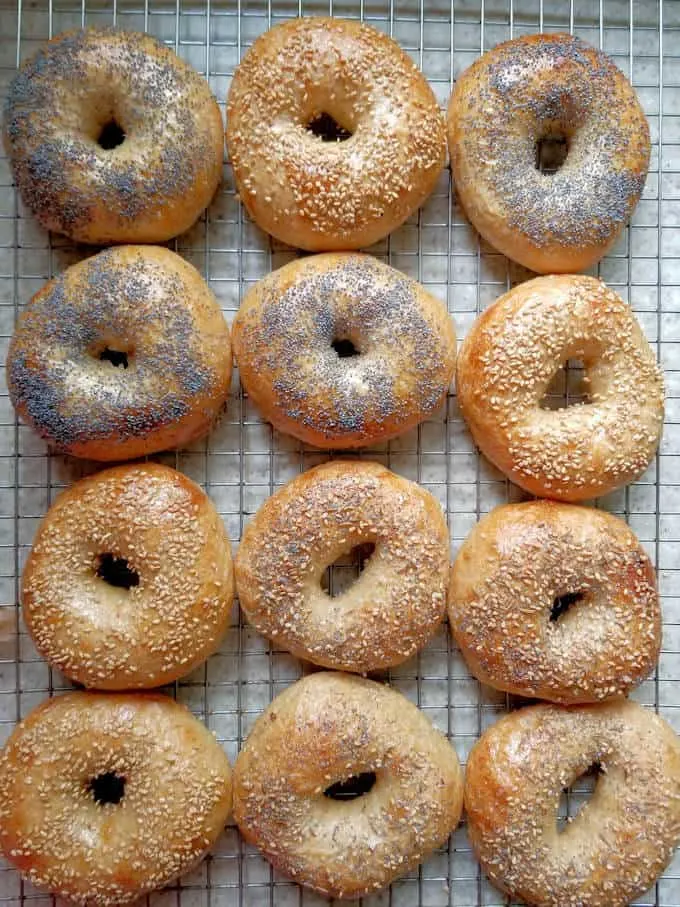
Recipe Tips
- Make sure your starter is very active and lively. I get the best results when I do two feedings in the days before making this dough. I keep several starters and use the Small Starter for this recipe because it requires two feedings before baking with it.
- To get a good bagel shape that will rise properly, you must create a tight ball of dough before making the ring. Use a cupped hand and surface friction to roll the dough into a ball. You can see how it’s done in the recipe video.
- Place the shaped bagels on sheet pan which has been sprinkled liberally with cornmeal or flour. If the bagels stick to the pan you will loose volume when transferring them to the water. I find cornmeal works best, but flour will work too.
- In the morning, take the bagels out of the fridge and leave them out until the dough comes to room temp.
- Don’t start boiling the bagels until the oven is preheated. They should go into the oven within minutes of coming out of the water.
Storage
- Bagels are best the day they are baked. For longer term storage, slice the bagels about 3/4 the way through and pack them into freezer bags.
- Previously frozen bagels are best if toasted before serving.
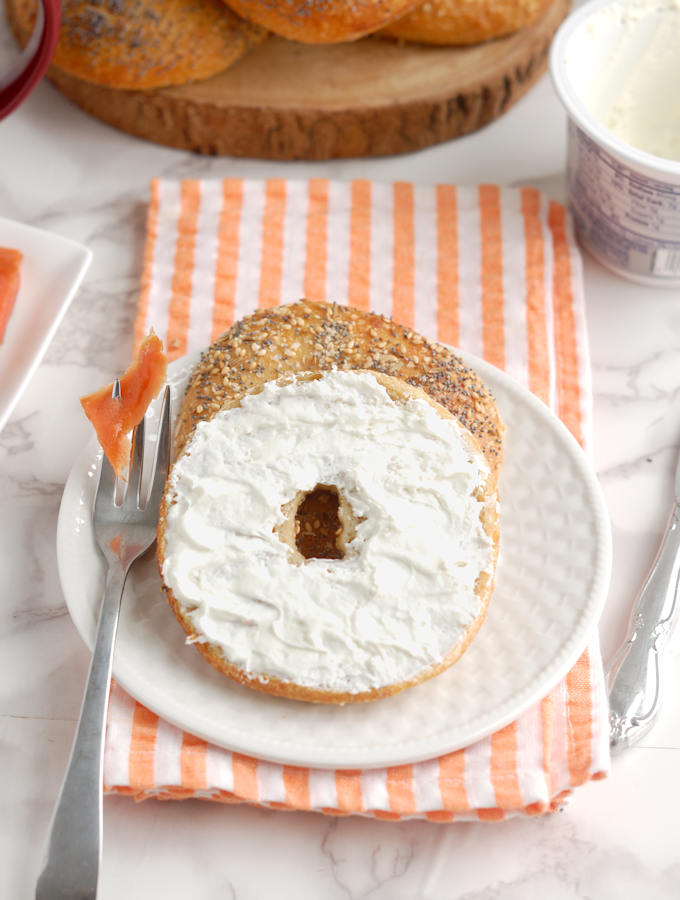
I know you hate to throw away that sourdough discard. Check out these recipes that use sourdough discard.
If you love this recipe as much as I do, please consider giving it a 5-star review.
Sourdough Bagel Recipe
Ingredients
- 8 oz active sourdough starter (1 cup (100% hydration))
- 12 oz warm water (1 ½ cups)
- 22 ½ oz bread flour (4 ½ cups, divided, see note)
- 1 ½ oz barley malt syrup (2 tablespoons (or honey + molasses))
- 1 tablespoon table salt
- 2 oz granulated sugar (¼ cup (for boiling))
- 2 teaspoons baking soda (for boiling)
- corn meal (for pan prep)
- 1 egg white (whisked lightly)
- Topping (sesame seeds, poppy seeds, caraway seeds or coarse salt)
Instructions
- Combine 8 oz active sourdough starter, 12 oz warm water and 2 cups (10 oz) of the flour in a mixing bowl. Mix to form a thick batter. Cover the bowl and set aside for 30-60 minutes.
- Add 1 ½ oz barley malt syrup and 1 tablespoon table salt. Switch to the dough hook. Add the remaining 2 ½ cups (12 ½ oz) flour and mix to combine. The dough should eventually cling to the hook and start to clear the sides of the bowl.
- Knead 5 minutes on medium speed. If working by hand, stir in as much of the flour as you can, then turn the dough out onto a lightly floured surface and knead in the remaining flour. Knead 5 minutes. Form the dough into a smooth ball.
- Put the dough into a lightly oiled bowl, turning once to coat the dough. Cover the bowl and set it aside at room temperature. After 30 minutes uncover the bowl, lift one side of the dough and fold it into the middle of the dough. Repeat with the other three sides of the dough then flip the dough over. You're basically turning the dough inside-out to redistribute the yeast. Cover the bowl and repeat the procedure every 60 minutes for a total fermentation time of about 3 hours. The dough should be lively, elastic and airy. If the dough is still sluggish give it another hour or two at room temperature.
- Line a baking pan with parchment paper then generously sprinkle the paper with cornmeal (or flour). Turn the dough out onto a lightly floured surface without kneading out the air. Divide the dough into 10 even pieces. Use a cupped hand to roll each piece into a smooth, tight ball.
- To form a bagel, poke your finger all the way through the center of a ball to make a hole. Use two fingers to gently open up the hole. Continue gently stretching to form the bagel or twirl the dough around your fingers to widen the center hole to 1 – 1½" wide.
- Place the bagel on the prepared sheet pan and continue to form the remaining bagels. The dough will probably spring back a bit so you can go back and re-stretch the holes once you're done forming all the bagels. Cover the pan with plastic wrap. If the dough and the ambient temperature is on the cooler side, leave the shaped bagels at room temperature for 30 minutes then place the pan in the refrigerator overnight. If the dough and ambient temp is warmer and the dough is quite active, place the bagels into the refrigerator without leaving them out for 30 minutes.
- In the morning take the bagels out of the refrigerator and bring them to room temperature.
- Preheat the oven to 450 °F. In a large pot combine 1 gallon of water with 2 oz granulated sugar and 2 teaspoons baking soda and bring it to a boil. Reduce the heat to keep the water at a rolling simmer. Set a cooling rack over a sheet pan or kitchen towel and place it next to the stove. Line two half-sheet pans with parchment paper or silicone baking mats and generously sprinkle with corn meal.
- Once the oven is preheated, you're ready to boil. Gently lift a bagel off the sheet pan and lower it into the water, bottom side down. Depending on the size of your pot, you can boil 3-4 bagels at a time. Boil the bagels for 30 seconds then flip them. Boil the other side for 30 seconds. Repeat the process again for a total of 2 minutes boiling time. Remove the boiled bagels from the water and set them on the cooling rack to drain.
- Place 5 of the boiled bagels on each sheet pan. You could fit them all on one pan but they may stick together as they bake.
- Brush the bagels with egg white. Add the topping(s) of your choice. To make "everything" bagels combine a tablespoon of each of sesame seeds, poppy seeds & salt with a 1/8 teaspoon garlic powder and onion powder. Bake until golden brown, about 20 minutes.
Would you like to save this recipe?
As an Amazon Associate and member of other affiliate programs, I earn from qualifying purchases.









Hi
Thanks for the recipe…I am in the middle of it … as a total newbie to sour dough, I was wonder If you should add moisture to the oven while baking?
Not necessary. There’s a lot of moisture from boiling.
Thanks for the quick reply! These bagels turned out really well, thanks for the recipe and well thought out instructions!
Can I make these with a “mix in” like cinnamon and raisins or blueberries (as opposed to just putting something on top)? If so, at what point in the process would you recommend adding them? Thanks so much!
I do believe some folks have made cinnamon raisin bagels with this recipe. The cinnamon can go in while mixing the dough, with the malt syrup and salt. I would fold in the raisins just before shaping the dough. Since you’ll be knocking out more air by kneading in the raisins the rise might be a little slower.
Thanks so much for the recipe! I added a few tbsp more of flour (using King Arthur special patent – 12.7%) and used 1 1/4 Tbsp molasses to replace the 2 Tbsp barley malt syrup. They stayed in the fridge for a solid 8 hours, and about a 45-70 minute rest at room temp (worked in batches of 8). After boiling, sprinkles directly with toppings on a wire rack and then placed on a sheet tray with semolina. Baked directly on a preheated pizza stone at 450 (convection) for 15 minutes, they were perfect! Chewy, beautiful flavor.
I had an issue with these rising properly. Did the 30+ mins on the counter before proofing them overnight in the fridge and then allowed them to it on the counter for 2 hours in the morning as they had not risen in the fridge. When I boiled them, they were VERY delicate and hard to work with and did not rise very much (at all) in the oven. The taste is great but the appearance is lacking. Any suggestions about how to improve in the future? Does it sound like the dough was too wet?
Did the bagels begin to rise during that last 30 mins before refrigeration? Usually by that point my dough is active enough that I will see them beginning to puff during that 1/2 hour. The key to getting a good rise and proper structure for these bagels is the fermentation stage. The total time needed for fermentation will vary based on your starter, the temp in the room and the temp of the other ingredients. Was your dough nice and aerated and springy before you shaped the bagels? If not, give them more time. Did you weigh your ingredients or use cup measures? Is your starter a 100% hydration starter?
I’m making my second batch of these – first were delicious – and I’m curious about something. My starter was active, passing the float test, and I kneaded for about 8 minutes until dough was smooth and sprung back nicely.. However, I’ve now gone through the 3 hour fermentation and have had a difficult time during the stretch and fold. The dough is not very extensible so I’m having a hard time making the folds. It also drags a bit from my fingers due to the high tenacity. I’m going to let it ferment another 1-2 hours, but wondering why the dough is so hard to elongate during the stretch and fold phase. Also, how would I know how long is too long to ferment? Thank you!!!
I just made another batch of these yesterday and I will say that when I have given my starter a double feeding (2x in 2 days) I get a much better result.
Hello!
Thank you for this recipe.
All steps were very clear and by bagels turned out beautiful – wonderful aeration and a crisp/chewy crust that I love.
I kneaded for longer than 5 mins as I was doing it by hand and I needed to add another ~1/2 cup flour to get the nice smooth dough to form. I was slightly worried in the morning that maybe they hadn’t achieved the 50% rise but I left them out a bit longer and not much changed. I boiled them anyway and then they rose beautifully in the oven becoming rounded and shiny.
I also skipped the egg white as we are vegan but it still worked wonderfully with no sub.
Thanks for a great recipe will use again!
Great. If you’re in the UK I know that flour can be different so I’m glad the recipe worked out.